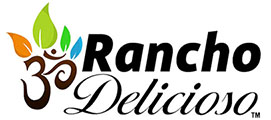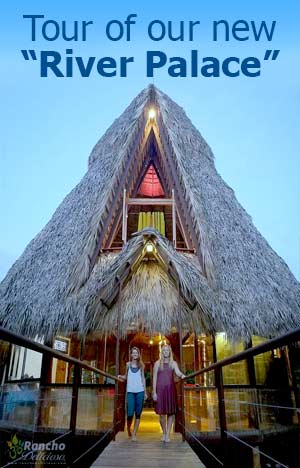Tropical Seeds for Making Jewelry
For 11 years I was half owner of a jewelry company called Seventh Sense, and we scoured the planet looking for exotic beads and materials of all types to make our jewelry. Although I’ve left that business far behind, I still love the idea of making jewelry, and am always keeping my eye open for beads or jewelry materials we can produce on the farm, made from the seeds of various plants, find on the beach, or discover growing wild.
Many great seeds that are used for jewelry come from rare vines that are very difficult to spot, except when they occasionally bloom or drop their seed pods. I discovered one of these growing in the old-growth jungle at our river. This was the “sea bean” that looks like a miniature hamburger and is found washed up on the area’s beaches from time to time.
When I first moved to Costa Rica, I made and wore a bracelet made out of Guanacaste seeds from the huge tree growing at Anamaya. I made the mistake of wearing it while swimming and the seeds absorbed water and swelled up, ruining the bracelet. Lesson learned: never get jewelry wet when it’s made from seads or beans!
We have or can find these here nearby the farm
Canna (Canna Indica)
http://en.wikipedia.org/wiki/Canna_indica
4-5mm round black. We mistook this for arrowroot because it was sent to us as such.
Canna indica sps. can be used for the treatment of industrial waste waters through constructed wetlands. It is effective for the removal of high organic load, color and chlorinated organic compounds from paper mill wastewater. http://www.rite-ways.com/SoilBioFiltrationSTP.html
Cenizaro (Albizia saman)
http://en.wikipedia.org/wiki/Albizia_saman
These medium sized brown seeds look like miniature Guanacaste seeds, and come in pods surrounded by a sticky sweet syrup.
Guanabana – Soursop (Annona muricata)
http://en.wikipedia.org/wiki/Soursop
Black smooth hard oblong seeds
Guanacaste (Enterolobium_cyclocarpum)
http://en.wikipedia.org/wiki/Enterolobium_cyclocarpum
Large, flat beautiful beads from the “monkey ear” tree
Job’s Tears (Coix lacryma-jobi)
http://en.wikipedia.org/wiki/Job%27s_Tears
White, grey, brown seeds that have a natural hole in them. Very pearly, and grow on small grassy bushes easily here on the farm once established.
Mukuna – Sea Beans (Mucuna sloanei)
http://waynesword.palomar.edu/mucuna.htm
Large flat round seeds, usually found on the beach. They are from a vine, and the seeds have a circle of painful stinging hairs on them when taken from their pods.
Photos and list of “drift seads” found on beaches: http://waynesword.palomar.edu/nicker.htm#nicker1.gif
Tropical Beads We’d Like to Plant
Coralwood Tree – Red Bead Tree (Adenanthera pavonina)
http://en.wikipedia.org/wiki/Adenanthera_pavonina
http://www.flowersofindia.net/catalog/slides/Red%20Bead%20Tree.html
Bright red round seeds, with many, many different names. Acacia Coral, Bead Tree, Circassian Seed, Coral Wood, Coralitos, Curly Bean, Jumbi-Bead, Peronías, Red Bead Tree, Red Sandalwood, Red Barbados pride, Peacock flower fence, Saga, and Manchadi are common names.
Kukui Nut Seeds (Aleurites moluccanus)
http://en.wikipedia.org/wiki/Aleurites_moluccanus
Shiny brown seeds. The fruit is full of oil and can be made into a natural candle.
Mary’s Bean (Merremia discoidesperma)
http://waynesword.palomar.edu/plmay96.htm
Known as the “crucifiction bean” because it has a cross pattern pressed into its surface.
These large seeds are used as the centerpiece in a necklace. They come from a small papery fruit on vines growing on the Pacific coast of Costa Rica.
Mgambo – (Majidea zanguebarica)
Velvet-covered seeds also called “black pearls”
http://en.wikipedia.org/wiki/Majidea_zanguebarica
Nickernuts (Caesalpinia major)
http://waynesword.palomar.edu/nicker.htm
Large marble-like round/oval seeds. There are three species that come in yellow, grey, and brown. They grown on a spine-covered shrub on tropical beaches.
Ormosias – Jumby Beads (Ormosia_coccinea etc)
http://en.wikipedia.org/wiki/Ormosia_coccinea
Bright red small seeds that grow on Costa Rica trees. There’s many species, with different seeds.
This is the famous seed (kuru) of the manjadi tree (manjadikuru). Also known as Circassian Seeds
Lots of great info here on these beads: http://waynesword.palomar.edu/plmar97.htm
Rosary Peas (Abrus precatorius)
http://en.wikipedia.org/wiki/Abrus_precatorius
Red and Black ovals from a highly invasive vine.
Royal Poinciana / Flamboyant (Delonix regia)
http://en.wikipedia.org/wiki/Delonix_regia
Long, brown/tan, “tube” beads from a leguminous tree, covered with gorgeous red flowers, very impressive in bloom. In guatemala it’s called “Llama del Bosque”
Rudraksha (Elaeocarpus_ganitrus)
http://en.wikipedia.org/wiki/Elaeocarpus_ganitrus
Round wrinkled seeds from a tropical tree, used to make mala rosary necklaces in India
Tagua Nut Tree (Phytelephas)
http://en.wikipedia.org/wiki/Phytelephas
Tagua Nut Palm Tree seeds are carved and used like ivory. The most commonly used is Phytelephas Macrocarpa.
Wild Tamarind (Leucaena leucocephala)
http://en.wikipedia.org/wiki/Leucaena_leucocephala
Small flat round, and brown. They grow in long flat pods on a tree.
Used as jewelry: http://www.uncommoncaribbean.com/2013/11/14/uncommon-buy-handmade-wild-tamarind-wares-in-antigua/















